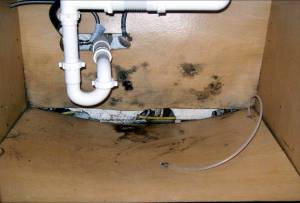As everyone knows by now, where there’s moisture in a building, mold growth is likely to follow. Sometimes there is mold growth because of what is referred to as “life style” issues, such as not using fans in bathrooms when taking hot steamy showers, or running several loads of laundry without proper ventilations or simply having too many people living in too small an area without sufficient ventilations or living in a damp climate such as Seattle, WA.

Visible Mold Under Sink
But most of the time we find mold in buildings it’s because somewhere there has been a water leak or some type of water intrusion. If drywall, ceiling treatments, carpet get wet enough for a long enough time and mold will grow. Mold needs moisture and organic material to grow on – that’s all!

View through an IR Camera
Using an infrared camera, usually referred to as an IR camera, helps the inspector quickly determine which building materials are wet or damp. The camera captures a visual image of the amount of heat emitted by all of the objects in the view finder. The higher the heat emitted by an object, the great the IR radiation emitted. Wet or damp materials are a different temperature than dry materials so they appear as a different color in the view finder.This allows us to pinpoint the materials that are wet and likely to be an environment that can sustain mold growth. Although the cameras are expensive – well into five figures – and therefore can add to the price of a mold investigation they are essential to performing a through mold investigation.
Using non-invasive IR technology in combination with moisture meters as diagnostic tools we can help advise our clients as to which building materials need removal, and the data helps us to more quickly determine the underlying cause of the water leak
As everyone knows by now, where there’s moisture in a building, mold growth is likely to follow. Sometimes there is mold growth because of what is referred to as “life style” issues, such as not using fans in bathrooms when taking hot steamy showers, or running several loads of laundry without proper ventilations or simply having too many people living in too small an area without sufficient ventilations or living in a damp climate such as Seattle, WA. But most of the time we find mold in buildings it’s because somewhere there has been a water leak or some type of water intrusion. If drywall, ceiling treatments, carpet get wet enough for a long enough time and mold will grow. Mold needs moisture and organic material to grow on – that’s all!
Using an infrared camera, usually referred to as an IR camera, helps the inspector quickly determine which building materials are wet or damp. The camera captures a visual image of the amount of heat emitted by all of the objects in the view finder. The higher the heat emitted by an object, the great the IR radiation emitted. Wet or damp materials are a different temperature than dry materials so they appear as a different color in the view finder. This allows us to pinpoint the materials that are wet and likely to be an environment that can sustain mold growth. Although the cameras are expensive – well into five figures – and therefore can add to the price of a mold investigation they are essential to performing a through mold investigation.
Using non-invasive IR technology in combination with moisture meters as diagnostic tools we can help advise our clients as to which building materials need removal, and the data helps us to more quickly determine the underlying cause of the water leak




